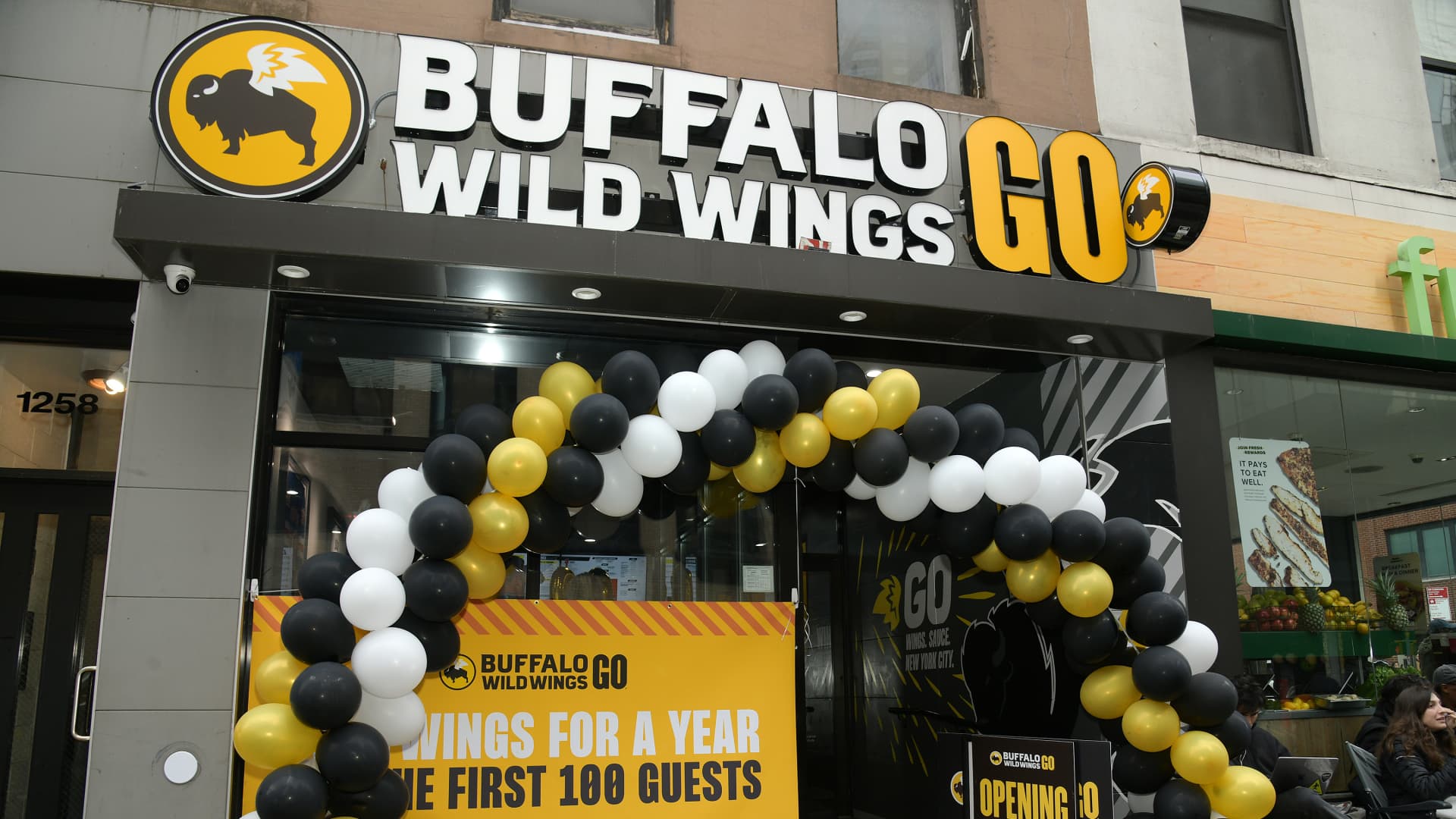The 100th location of Buffalo Wild Wings Go opened Wednesday on the Upper East Side in Manhattan.
Source: Buffalo Wild Wings
Buffalo Wild Wings opened its 100th Go location on Wednesday in New York City, four years after unveiling the quick-service offshoot of its sports bar chain.
BWW Go sells the chain’s famous chicken wings and other classic menu items, but its locations are smaller and limited to delivery and takeout orders. For the sports bar chain, it’s a way to make its brand even more ubiquitous, while offering customers more convenience.
Since 2018, Buffalo Wild Wings has been a part of Inspire Brands, which is backed by private equity firm Roark Capital. Initially formed after a merger between BWW and Arby’s, Inspire has since added other chains including Sonic Drive-In, Jimmy John’s, Dunkin’ and Baskin-Robbins.
Inspire is reportedly considering going public in late 2024 or 2025 and seeking a valuation of $20 billion.
BWW is the second-largest U.S. casual-dining chain in the bar and grill category with a market share of 14.4%, trailing only Dine Brands’ Applebee’s, according to Barclays research. It’s carved out a chicken wing dominance among its closest competitors, serving more than 3 million gallons of ranch and blue cheese dressing in 2023.
But the casual-dining segment has struggled, with publicly traded rivals like Chili’s and Red Robin perpetually stuck in turnaround mode.
Buffalo Wild Wings’ revenue fell 1% in 2023 to $2.32 billion, according to franchise disclosure documents. A fast-growing spinoff like Go could make Inspire more enticing to potential public market investors.
Opening a traditional Buffalo Wild Wings location requires anywhere from $2.44 million to $4.83 million in initial investment, depending on the restaurant’s location and other factors, according to franchise disclosure documents. In comparison, a Go location will set a franchisee back roughly $560,000 to $1.05 million.
While a BWW sports bar is around 6,000 square feet on average, a Go location is roughly 1,500 square feet. That means cheaper real estate that’s faster to build and easier to operate.
“With the ability to fit into smaller footprints, it has the recognition of an established brand with the unlimited potential of an emerging one,” said Jack Litman, president of the Munson Group and franchisee of the 100th Go location.
Taking over takeout
The Go format is primarily meant to reach the customers who sometimes don’t want to ditch their couches for a sports bar.
Before the pandemic, off-premise orders accounted for 15% of Buffalo Wild Wings sales, according to John Bowie, brand president at BWW. Now, takeout and delivery make up roughly a third of the BWW’s sales.
“This was an opportunity for us to take the takeout portion of the business, put it inside a freestanding unit and put it very conveniently located to where our customer is,” Bowie told CNBC.
As of Wednesday, BWW has branded its entire off-premise business under the Go name, too.
Buffalo Wild Wings Go
Courtesy: Buffalo Wild Wings Go
BWW’s off-premise growth mirrors that of the broader chicken wing category, which soared in popularity during the pandemic. Like pizza, chicken wings travel well when delivered, but they also offer more variety, with an array of sauces and rubs to switch up the flavor.
While pizza chains like Domino’s and Pizza Hut have seen their sales struggle since the pandemic as pizza fatigue sets in, chicken wings haven’t slowed down in the same way.
For example, fast-casual chain and stock market darling Wingstop has reported strong same-store sales growth for the last year and half, bucking industry trends. Bernstein analyst Danilo Gargiulo wrote in a February research note that Wingstop has the potential to be “the next Domino’s.” (Roark Capital previously owned Wingstop but exited its investment a year and a half after the chain’s IPO.)
Other chains are now also looking to chicken wings to bolster their sales. Restaurant Brands International’s Popeyes added chicken wings to its menu permanently last year.
BWW Go also gives the chain the opportunity to compete better with its fast-food rivals. The chain can tweak its limited menu to appeal to the customers looking for a convenient dinner.
BWW Chief Marketing Officer Tristan Meline told CNBC in the future the chain may lean into offering more special sauces, menu items or deals to Go customers.
Growing interest
BWW plans to keep adding to its current footprint of more than 1,300 sports bars, but Go will be opening locations at a much faster rate, according to Bowie.
“It takes a long time to get a sports bar approval and to build a sports bar, but we’ve already seen with the 60 franchisees we have now that they can start stamping these out, and the growth will be very exciting,” he said.
BWW already has nearly 600 commitments from franchisees to open additional Go locations. About 85% of its operators also franchise with other chains owned by Inspire, like Dunkin’ or Arby’s.
But the calls to franchise are also coming from outside of Inspire; Bowie said that he’s been hearing from large franchisees that already operate multiple concepts.
The chain plans to open another 50 Go locations by the end of the year.

